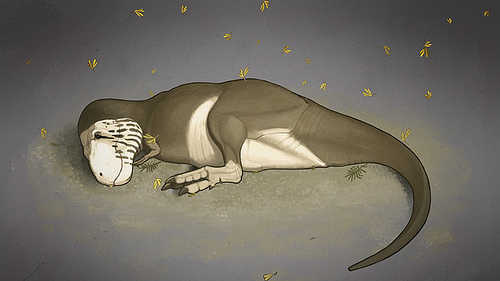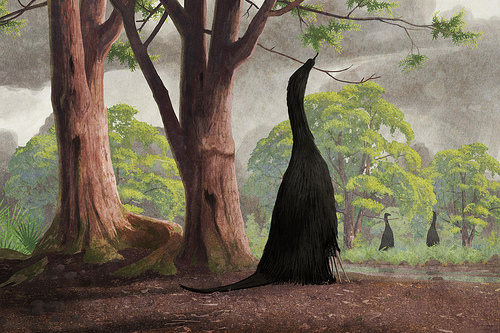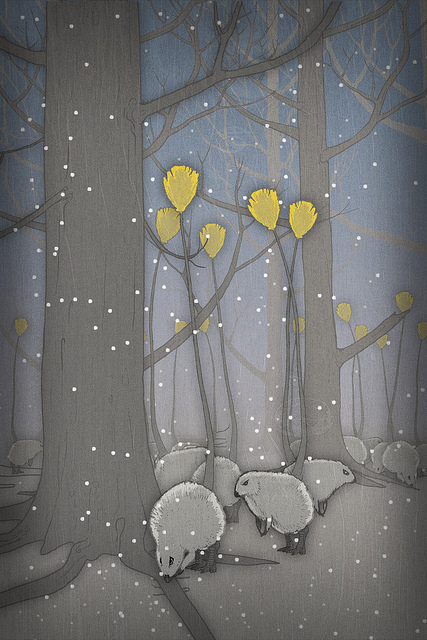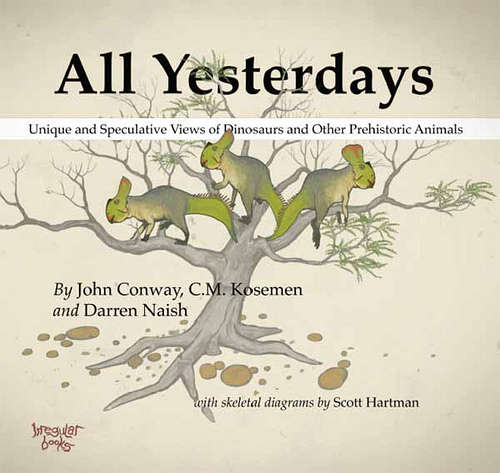I touched on some of the issues of illustration in biology when I read Jean-Baptiste de Panafieu and Patrick Gries’ Evolution, and while that point is largely moot when it comes to everyone’s favorite subjects—dinosaurs—there are points of the argument that are still illuminating. Dinosaurs—any extinct prehistoric animal, really—require interpretation, guesswork and assumptions. The trick is, at some point those assumptions become part of the subculture, turning into an unofficial visual canon. Popular culture plays a role in this, as well; dinosaurs are tremendously inspiring and evocative, so people have strong opinions about them. Opinions unrelated to science. We’ve seen this in the reluctance of scientific illustration to adopt the “feathered dinosaur” motif, just as we had foot dragging on the topic of whether dinosaurs were ectothermic reptiles or “warm-blooded” like birds. All Yesterdays, by Darren Naish, John Conway, C.M. Kosemen and Scott Hartman, takes a look at that cutting edge of speculative paleoart, trying to look at things “outside the box.”
Brightly colored predatory Carnotaurus waving its arms around to attract a mate, long-necked elasmosaurs stretching their necks into the air in acrobatic displays of fitness, an Allosaurus and prey-animal meeting without bloodshed, an herbivore snacking on a giant centipede—some of the illustrations here are predicated on behavioral shifts.
Seeing “action packed” montages, conventional illustrators may have missed quieter scenes and Conway, Kosemen and Naish are explicitly trying to fill in those blanks. These aren’t fringe conspiracy theorists or amateurs, either— Naish is a paleontologist whose credentials you can check out by way of his Scientific American blog, John Conway’s paleo-art speaks for itself, and you may already by acquainted with C.M. Kosemen from his Snaiad project.
Everything behavioral is speculative when it comes to dinosaurs, but we get so used to the “predator jumps prey!” or “herbivore munches leaves!” paradigms that we start seeing those as—well, as the default, while they are just as imaginary as anything else. Also: sleeping T-rex!

On a personal note, I found the Ouranosaurus to be the most evocative part of the book, but I do really mean that from the narrow window of my own life experiences. See, while I studied anthropology—witness How to Think Like a Neandertal—that included some general anatomy, along the way. One of the musculo-skeletal classes I took had a final that was largely just pictures of skeletons that we were expected to say a few words about. One of them was a creature with long spines on its back—the spinous process, I still remember what that is called—and I knew enough to speculate that it was either a sail or, more likely, a fatty deposit. Showing the Ouranosaurus with a hump rather than a fin validated that college memory.

The thing that makes All Yesterdays really stand it are the illustrations, but the writing is on point, as well. Eschewing the academic tone for a conversational one that isn’t self-aggrandizing and isn’t condescending, the summaries for each illustration explain the whys and wherefore behind the artist’s choices. Fuzzy Leaellynasaura with long, flagging tails— why? Therizinosaurus cloaked in feathers with its big claws out of the way as well, resulting in a really striking and almost alien picture. Heterodontosaurus-related fossils have been found with spine-like hairs, and so in its pictures here it is shown covered in quills, or as the authors would have it, they went “whole (hedge) hog.” That sense of humor is a welcome departure from the sometimes dry tone of science non-fiction.

The book ends in a really great thought experiment they call “All Todays”: what if we took the skeletons of existing animals and re-imagined them, using the same logic that we apply to dinosaur fossils? That is, pretend we don’t have anything besides the bones and only a very fragmentary record of skin and muscle—what then? The cat is a good example of this; the distinctive feline face is lost in a reconstruction, as is, for instance, the fat body of a cow. The tusk-like teeth of a hippopotamus—have you ever looked at their skulls?—are cast as evidence of their status as peak predators.

Spider monkeys and baboons are perhaps the eeriest reimaginings; they fall right into the Uncanny Valley, with the authors “supposing” that the grooves in baboon teeth must be evidence of their venomous nature. Birds are another curious case; if you cancel out your knowledge that birds come with feathers and that the vast majority of them fly, you end up with…well, something like strange dinosaurs or pterasaurs. Which brings home the point of the exercise; it is important to recognize the shortcomings of adhering to commonly held wisdom. It is an appeal to Feyerabend; nothing so radical as epistemological anarchism but rather an argument the consistency criterion, a paean to the idea that challenging accepted ideas is good and important—and one of the best ways to advance scientific understanding.
Mordicai Knode’s favorite dinosaur is Deinonychus, and has been ever since he was a very tiny little Mordicai clutching armfuls of dinosaur and fantasy books. Tell him your favorite on Twitter, and find him on Tumblr.











This reminds me of a fascinating condensed story I read as a kid in my mom’s Reader’s Digest. In it, an archaeologist interprets the various trappings and deorations of an ancient burial mound that—to anyone of our day—is clearly a roadside motel.
1. rowanblaze
Yeah, the “Nacirema” are the sort of traditional anthropological satirical/objective look at the “American.”
I’m reminded of a reaction I had to the way the BBC’s Walking with Beasts special (or Walking with Prehistoric Beasts as it was known in the US) rendered one of its creatures, the Brontothere. As seen here, they showed it with kind of a concave shape to the top of its head with a big bone plate sticking up in front like a weird-shaped horn. It always seemed to me like that concavity might actually have been filled in — that maybe there was some cartilage and flesh forming a hollow structure there like a great big nasal cavity, maybe some sort of resonating chamber for their calls. I don’t know how likely that is, but I do appreciate the hazards of taking fossil evidence too literally.
Sleeping T. rex is cute.
3. ChristopherLBennett
…or maybe they had these big long tongues that worked like a snake’s tongue, & all those hollow sacs in the bone were to give it an awesome sense of smell! Or, or, or! See that is the genius of the book; it is too easy to get mired in one paradigm & really just viscerally “wow” to go outside of it.
@1 rowanblaze:
That might have been “Motel of Mysteries,” by David Macaulay. I remember the illustrations in the full book version very clearly. It came out in the late 70s, I think as a response to the renewed interest in King Tutankhamun in the U.S. Should still be available.
rowanblaze @1
Probably “Motel of the Mysteries”. I have a copy somewhere.
Checking Amazon I see it’s still in print.
I read “Motel of the Mysteries” in elementary school. I particularly recall the archaeologists’ conviction that the “sanitized for your protection” band around the toilet seat was a ceremonial headband inscribed with a sacred chant.
Really cool book that I might have to check out.
Re: Motel of the Mysteries
I remember reading a short story in middle or high school titled (based on a quick GoogleBooks search) “Weans” where an archeologist from the future unearths Washington D.C., which he translates as “Pound-Laundry.” He also takes fragments of the Postal Service creed (“Neither snow nor rain nor heat nor gloom of night stays these couriers from the swift completion of their appointed rounds.”) to mean that the civilization perished in an apocalyptic weather event.
I remember seeing statues of early scientific reconstructions of dinosaurs. All of them were croc-like (including the ones we now think are bipedal) as the scientists were thinking “super-sized reptiles” and crocs were the largest reptiles they knew.
9. DrakBibliophile
Yeah, pretty neat how the past is a moving target. Sideways ideas like the ones in here are part of what keeps that moving forward.
This is also true of the skulls claimed to be early humans. There is no way to tell what they looked like with skin on yet the illustrations always lean to a very human look when there may not have been one. Look at the Proboscis monkey, you’d ever guess it’s giant nose by simply seeing the skull… Which could also be made to look human…
11. B STATS
Wellllllll as someone with the very minimalist training of forensic anthropology– undergrad, so I’m not like, trying to be a knowitall– I can say that with humanoids there is a much better historical context, as well as fossil record. It would be like if there were some dinosaurs living– birds don’t count*!– & we were trying to guess what the rest looked like.
(* Alright birds sorta count)
What if you looked at it the other way then? Homo Habilis, Homo Erectus, Homo antecessor, Homo Sapien etc. etc. They could ALL very well be the same species (Human) if one looks at the fossils without any pre-conceived notions. For example take a look at your own face then check out the face of a little old woman from Tibet. You’re both still human even though you’re radically different! Look at the skulls of Caucasoid and Negroid peoples, are they a separate species? Of course not! They can mate with each other and produce fertile offspring because they are both human! However what many naturalistic evolutionists do in renditions is PURPOSEFULLY go for a very primate to very human look by adding or removing hair and using different skin colours and features to get the particular look they’re after. They may also fail to consider damage and warping done to the skulls from fossilization which would lead to a very different look as well. If there were no Apes or monkeys for people to get inspiration from then the renditions of these early human skulls would look COMPLETELY different! If I were to make my own rendition while staying faithful to the skull’s shapes I could produce vastly different faces also.
13. B STATS
Well, there is an ongoing debate over subdivisions– on account of many of the things you argue in favor for– but there are in fact other tools in the arsenal of anthropologists working on Hominin remains. Note, the “Hobbits,” which some argue are just microcephilic humans, nothing else. In point of fact “Hominin” as a phylogenic category really started coming into the forefront with genetic analysis, seperating out Homo & Pan.
The variations between human skull types– I try to avoid that akward old school terminology, though I know it is still in use in skull morphology– are hardly comperable to the differences between human & Neanderthal, for example. Points of variation in things like chin protuberance & nasal width don’t really compare to the rather large gulf between sapiens & neanderthalis. Of course they are similar; they are closely related. & yes, may have interbred, but then, that just goes to underline that biology isn’t a series of hard & fast rules; categories are things human brains put onto it, in an attempt to understand it & discuss it.
Very neat looking book! Thanks for bringing it to our attention, Mr. Knode. The “All Todays” section reminds me of a classic paleontological exercise: trying to decide into how many “species” we could/would divide up ol’ Canis lupus familiaris based on skeletal reconstruction. I mean, c’mon, Chihuahuas and Great Danes? Clearly different animals!
And, of course, there is the classic Terry Gilliam animation of the discovery of the fossilized remains of the big toe from the Big Foot that squelches the Monty Python opening sequence and its “reconstruction” into a sorta mammoth with a “big toe” trunk.
15. Eugene R.
I actually had an “argument” with an anti-evolutionary advocate in high school (how long ago that was!) where they said that a Great Dane & a Shih Tzu were clearly created uniquely. When I pointed out that they were both bred in the historical record, I sort of realized that those sorts of debates were…not really fruitful. Memories! Your point, though stands as a good one. Anything really polytypic screws up the whole system…& isn’t that partially the point of the current Triceratops debate, as I understand it?
This all looks incredibly adorable.
mordicai (@16): Yes, I think that the scientists arguing over Triceratops versus Torosaurus (Different species? Same species, different stages of development?) is a nice parallel for the point that Naish & Company are making with their “All Todays” examples – data does not just sit there and tell its own story; it needs to be interpreted to become knowledge. Good example!
Given that canine breeds can pretty easily be shown to be the result of … uhh, breeding (artificial selection), it is a shame that you had to converse with someone who thought to use it as an argument against the theory of natural selection. Well, maybe with your eloquence, you were able to unstop their mental corks and get some ideas a-flowing. And if not, we are happy to have you here doing same for us.
@16: “Not really fruitful” is an interesting choice of words. I’ve seen several people (including the writers of the George Burns movie Oh, God!) cite the convenient design of the banana as evidence of God creating the universe for humans’ benefit, even though the banana, like just about every other plant and animal product we eat, has been bred into its current form by human beings. The wild ancestors of the banana had much smaller, tougher fruit with much bigger, harder seeds and a much smaller quantity of edible flesh.
ChristopherLBennett (@19): Bananas as proof of Intelligent Design? (Well, maybe lowercase ‘intelligent’, anyway.) Lordy, wait till they find out about corn/maize, and then who’s designed for whom, I ask!
Oh no, don’t bring God into this :/ That’s all we need, emotional opinions based on personal faiths.
17. geniusscientist
IT IS CUTE AS HECK, yes, don’t let that be overshadowed!
18. Eugene R.
&
21. B STATS
Yeah, I usually don’t bother to start up those “debates.” You can’t have an argument with someone’s axioms, you can only hope their own faculties change or that education happens some other way…rhetoric fails.